
Introduction
The very first KidWind Challenge was held in a science classroom in Monterey, CA, in 2003. It was a spontaneous end of year project for Michael Arquin’s 6th grade science class. He had been searching for a fun open-ended wind project similar to Junior Solar Sprint that he had been doing with his students for years, but could not find anything similar in the arena. He spent a little time developing the idea, collected some materials and off he went with his classes. Based on the student response, it was clear this project idea had legs. Even though it was the end of the year, students were showing up before school and at lunch to work on their turbines. It was a blast!
Years later in 2009, with support from NYSERDA, KidWind held the first KidWind Challenges across New York State. These events were inspired by a wind energy challenge, WindEng, we discovered was being held at the University of Guelph in Canada. The University of Guelph had a real wind tunnel — so we first needed to solve a big problem. If we were going to hold the challenge in various locations, we would need a portable wind tunnel. Experts told us it that would cost $50K to make a portable wind tunnel, so we took it to some different experts and gave a group of high school students $1000 to build a portable wind tunnel – which they did! We carted this monstrosity around the state to our four Challenges. It wasn’t perfect but WOW it was fun. After those first four events, we were hooked. We have spent the last 10 years refining KidWind Challenge, and we are addicted to making them better, more interesting, and more challenging!
Every year the students get more imaginative and more inspiring. The devices that students construct continuously blow us away and keep pushing us to work harder and smarter to create authentic educational opportunities for students.
We can only imagine what the next ten years will hold!
Wind Resources
As you construct and test your wind turbine, you may want to learn (or learn more about) the major parts of a wind turbine, wind energy and other related topics.
Check out these sites to learn about wind turbines and wind energy in general:
How to Participate?
You can participate and prepare for KidWind Challenges in many ways. We recommend starting by exploring the website and trying an online wind or solar challenge. This will help you get a feel for the kind of devices you have to build and the kind of data you need to provide at a KidWind Challenge Event. Once you are ready you can take your devices on the road and participate in one of our KidWind Challenge events. Those top performers from the online and local events are invited to participate in the annual National KidWind Challenge.
Event Challenges
KidWind Challenge Events take place during the school year and are hosted by schools, community centers and organizations across the country. Please note that not every site will have both a wind and a solar challenge. KidWind Challenge Events may occur in person, online, or in a hybrid model. To find details about your local event, check out the Events page for your particular event and/or contact the local organizer. Learn more here.
National Online Challenge
The online challenge allows students to construct and test wind turbines and/or solar devices, and share the results with the KidWind community. Anyone, anywhere, can participate online. Every month we deliberate on the best projects and send prizes, t-shirts or other swag to the student winners. Monthly wind winners are also invited to the National KidWind Challenge.
There are no age or materials restrictions. Just share what you have created with our team and we will pick some of our favorites each month. Learn more here.
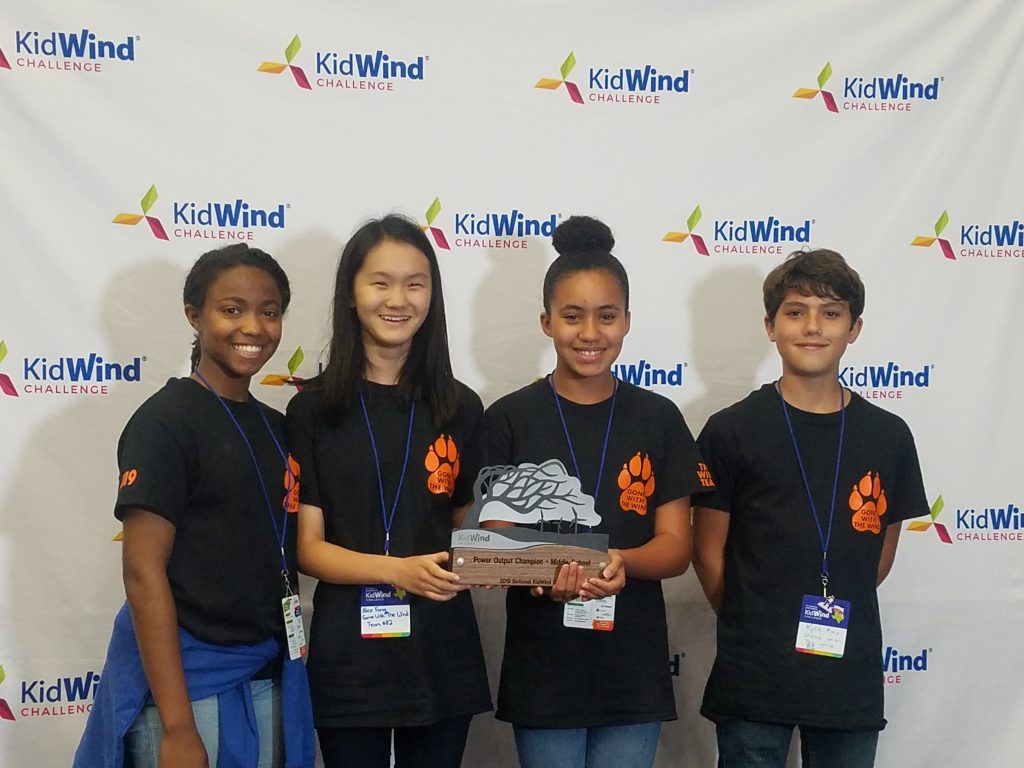

National Simulation Challenge
Last year, 90 teams participated in the first ever National Simulation Challenge developed in partnership with Flinn Scientific’s WhiteBox Learning (WBL). The Simulation Challenge allowed students from all over the United States to explore wind turbine blade and wind farm design in a game-like environment. To be selected as a top performer, teams had to master several complex concepts and work through hundreds of iterations to discover the best blade designs and wind farm architecture. The 2024 National Simulation Challenge begins on January 1, 2024. Learn more here.
World KidWind Challenge
Each year, the top 2 to 3 teams from our local wind events as well as the National Online Challenge winners are invited to participate in the World KidWind Challenge.
The location for Worlds change each year, though you can count on it taking place in May! More details can be found here.
Who Can Participate?
Virtual Challenges
Any student, anywhere in the world can participate in our virtual challenges. The General Online Challenge is open to all students in any grade or school setting. Many organizations and regions are also hosting online challenges, though these may have specific grade or geographic restrictions. While these Online Challenges are virtual, they do require you to build a physical structure. Students who are unable to physically build a turbine, may participate in our Simulation Challenge which is hosted via the WhiteBox Learning online portal and open to all students in all grade levels.
Event Challenges
Any group of students in grades 4 to 12 is eligible to enter a team in a KidWind Challenge Event. This includes students from public and private schools, home schoolers, after school clubs, Boy Scout and Girl Scout troops, etc. As long as you have a coach and a team, you can attend! There are no restrictions on the number of members on a team; however, large teams can be problematic as members may not have enough work to keep them occupied. Some large teams divide the students into groups with one half doing a wind challenge and the other half doing a solar challenge. Each team must have a coach. The coach will be responsible for registering the team for the competition and managing the team’s progress. Neither KidWind nor any local group will provide or be responsible for supervision of students at a Challenge. We require teams to make sure that there is one adult for every ten students who attend a Challenge.
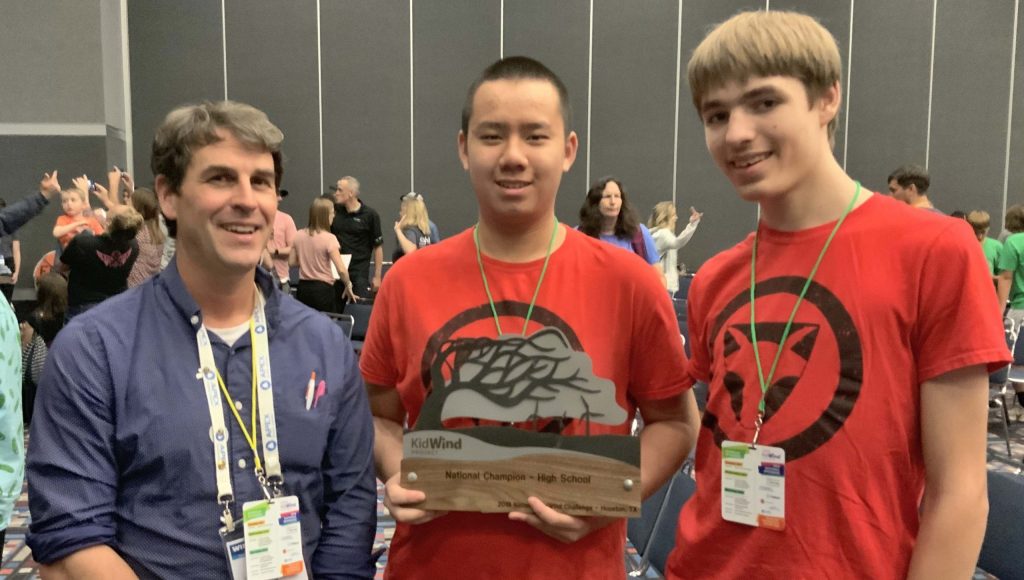
Can I Hold a KidWind Challenge?
Many educators ask us if they can host a KidWind Challenge. For the most part we say go for it, but start slow!
Start out by holding a KidWind Challenge in your classroom: upload a list of the team members to our online challenge and compete virtually. If that goes well, try to visit a KidWind Challenge near you to see a preview.
Holding a KidWind Challenge Event that is open to a large region can be complicated, but if you want to give it a try, we can help you! If you have some kind of wind tunnel, understand the rules, and want to invite local schools and have an event, shoot us an email and let’s go for it! To have a KidWind sanctioned event that will show up on our map you need to contact our team. We will help you make sure it is organized and well run. We often like to have one of our instructors come and help make sure the event meets KidWind standards.
We want to see KidWind Challenges and similar events all over the globe, which is why we open source all of our materials. But for us to put our name on an event we need to be confident the event has all the official components.
What Does an Event Look Like?
The KidWind Challenge network of partners and volunteers is vast.We hold events all over the world in many different venues. We want these events to be driven by the energy and vision of our local partners. This means that while every KidWind Challenge is similar,they are not exactly the same.Most events follow our general rules and rubrics, but there may be some variations in schedules, events, judging, and instant challenges. Please contact your local organizer for details about your specific event.
Food
Typically we do not provide food at events, although this depends on the budget we have for the event. Sometimes the Challengeis located in areas where food can be purchased and other times you may want to make sure that students bring their own lunches.Please check the KidWind Challenge website and connect with your local coordinator to see if lunch will be provided.
Supervision
We ask that coaches bring their teams to the competition and that they bring one adult supervisor for every ten participants.
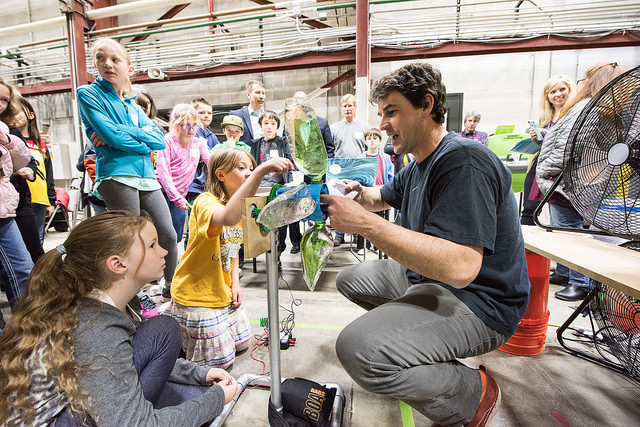
Sample Schedule
- 8:00am–9:30am
Arrivals + Set-up
Typically your team will arrive at a KidWind Challenge and be given a table or space to set up your turbines/or solar device. As your team checks in, we will usually distribute any materials needed. At most Challenges, we will have the wind tunnel out so students can make any final tweaks to their projects and will provide a tool area so that they can make any last minute repairs. We will also have lamps set up for testing solar devices.
- 9:30am
Announcements & Introductions
At this time, we will convene the teams, introduce the judges and give participants some idea as to how the day will progress.
- 9:30am–2:00pm
Turbine, Solar Device, and Team Evaluation
Although the exact time of the overlapping events depends on how many teams arrive at a Challenge, this generally takes two to four hours. Many different events take place during this time. Teams are typically assigned times for each event to make sure they accomplish each task.
- 2:00pm
Evaluation Events Completed and Judges Tabulate Scores
- 2:30pm
Results and Prizes Announced
- 3:00pm
End of Challenge
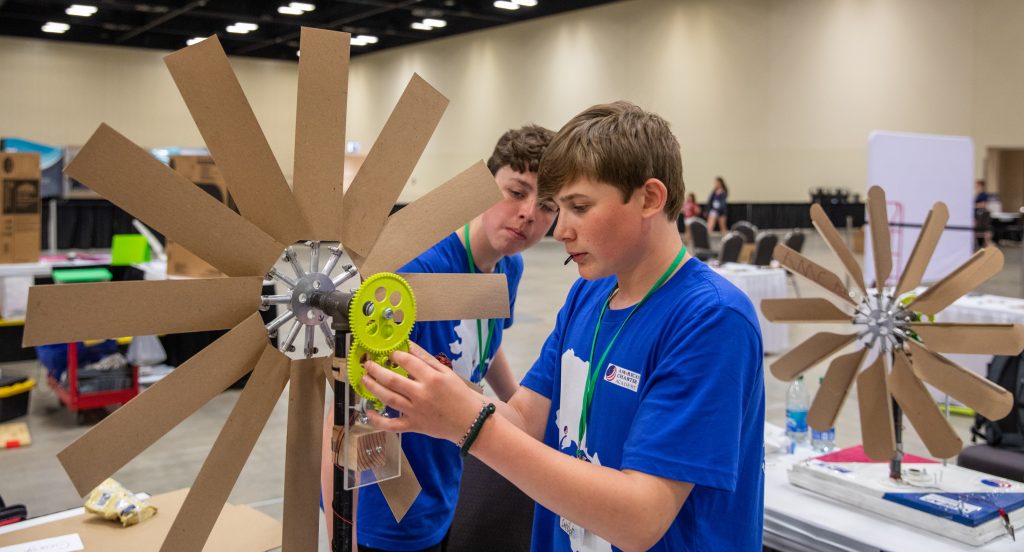
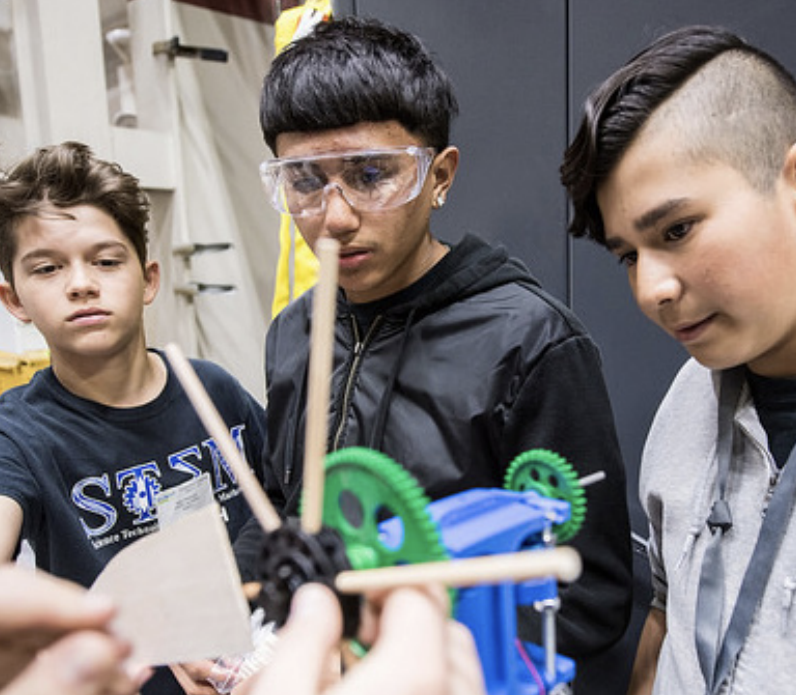
Participation Checklist
There are two ways you can participate in a KidWind Challenge: Online or at a KidWind Challenge Event
KidWind Wind Challenge Online
- Explore student turbines on the Online Challenge
- Learn about the basic parts of wind turbine
- Get some turbine-building equipment
- Build a turbine
- Test and improve your turbine, over and over
- Collect some data about your turbine
- Upload information about your turbine and your team to the Online Challenge
- Wait to see if you are the monthly winner
KidWind Wind Challenge Event
- See if there is a KidWind Challenge event nearby
- Find a coach and form a team
- Send your coach to a virtual or in-person workshop
- Explore student turbines on the Online Challenge
- Learn about the basic parts of a wind turbine
- Get some turbine-building gear
- Build a turbine
- Test and improve your turbine, over and over
- Collect some data about your turbine to share with judges (notebook, video, etc)
- Fill out your Wind Project Profile Form
- Before you go to the Event Challenge try the Online Challenge
- Get to Event Challenge and have fun
- If you place in the top two, get an invite to the National KidWind Challenge
KidWind Simulation Challenge
- Make sure you have an internet connected computer
- Register for the Simulation Challenge here
- Receive your WhiteBox learning log-in details
- Get to work once it opens on January 1
Don’t forget to register your team for your local KidWind Challenge! Check the website for upcoming events in your area and links to registration.
What do I bring to the Challenge?
- Turbine
- Wind Project Profile Form
- Extra parts, just in case
- Tools, just in case
- Pen/Pencil
- Snacks
- Water bottle
- Extra documentation for the judges (poster, notebook, photos)
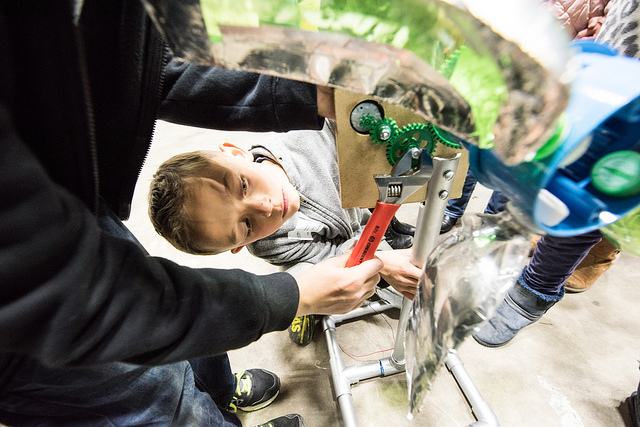
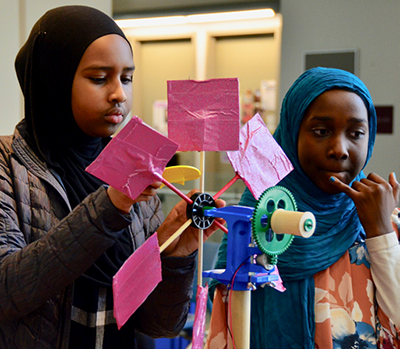
Wind Challenge Divisions
There are three possible age divisions:
- Elementary Division (4th-5th Grade)
- Middle School Division (6th-8th Grade)
- High School Division (9th-12th Grade)
The generator your turbine uses determines how we classify and evaluate your turbine performance in the wind tunnel. There are three classes of generators you can use:
- KidWind Generators
- Home-built generators (AC or DC)
- Advanced Generators (AC or DC)
If you use a KidWind Generator, you will be placed in the KidWind division.
If you purchase a generator, you will be placed in the Open Division.
If you make your own generator, you will be placed in the Homebuilt Division.
Only teams participating within the same division will be competing against each other.
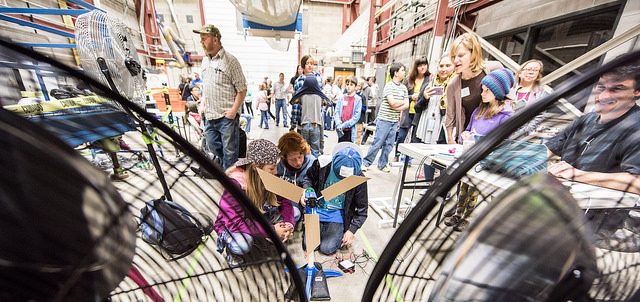
Who Has to Show Up?
To be eligible for the competition, all members of your team must be present on the competition day. We also require one adult for every ten students who attend.
Exceptions include:
- Some of your team members are unable to attend because of a scheduling conflict with a school sanctioned trip
A team member cannot attend due to an illness or family crisis
Can I Change Generator Divisions at an Event?
The short answer is it depends. Generally we want students to experiment and be ready to compete. WE realize that sometimes things do not work as planned and you want to make a change. Teams should realize that if you change to a different generator division you may get fewer tests and fewer chances to tweak and improve your device. Once the tunnel testing is closed, you will need to declare the division you would like to be placed in. Events are very busy and, at this point in the event, we will not have full scores tabulated, so you will need to make an educated guess as to which division you will want to compete in.
For more details and clarification, please contact your local event organizer.
Equipment to Build Your Turbine
Whether you’re building a turbine for an online or challenge event, you will need some basic gear to get started KidWind, through our partners at Vernier, have a number of kits and materials to get you exploring, but you can use gears from anywhere to participate in a KidWindChallenge as long as you are not violating the rules.

Generators
The generator your team uses determines how we classify and evaluate your turbine in the wind tunnel and compare energy and power generation. There are three classes of generators you can use.
KidWind Generator (KIDWIND DIVISION)
The easiest path to get a few KidWind Turbine Generators is from Vernier. If you use this generator, you will be placed in the KIDWIND division.
Advanced Generators (OPEN DIVISION)
You can purchase a commercially sold AC or DC generator (not a KidWind generator) that better matches how much power your turbine can generate.
Homebuilt Generator (HOMEBUILT DIVISION)
You can construct your own generator using a kit, online plans, or your own ingenuity. A home built generator is defined as a generator where ALL of the major components of the generator are constructed by the students. This would mean the coils are wound by the students, the stators and other components have been constructed, 3D printed or otherwise built by the team. This does not extend to the magnets or driveshafts and similar components in this device.
If you’d like to build your own generator, our partners at Vernier sell the GENPack (KW-GP) or the simpleGEN (KW-SGEN) which can be a good way to start learning about building your own generator and conditioning AC to DC. You can also find many more resources and kits online about building your own generator. For the really studious, check out Homebrew Wind Power by Dan Bartmann and Dan Fink and construct your own generator and turbine from scratch!
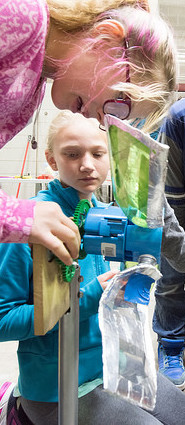
The key to using a homebuilt or advanced generator is to make sure the power output does not exceed 30V at 1A at any point in testing. You will also have to properly match a load to your generator for maximum efficiency. This can get complicated!
Before a KidWind Challenge event begins ALL teams must declare the generator division they wish to participate in (KidWind, Open, or Homebuilt). Judges will inspect your generator to confirm the division. Please make sure that your generator is visible.
Once a team makes their first wind tunnel run, they will be locked into the division they have declared. Turbines may be marked with colored stickers to indicate their generator division.

Blades
Wind turbine blades and their orientation to the wind are very important parts of a wind turbine design. You could study this for years and still not be an expert! The only rule we have about blades is you cannot use pre-made airfoils and your blades should be made of safe materials. We see students using all kinds of materials to make blades: cardboard, balsa woods, 3D.

Gearboxes or Belt Drives
While building a gearbox or a belt drive can be challenging, it can also greatly increase the power output of your wind turbine. Belt drives or gears can give your wind turbine a mechanical advantage and multiply the mechanical force of the turning blades.
Your team can use KidWind gearboxes and parts through our partners at Vernier, you can find parts from other vendors, or you can construct your own gearboxes or belt drives. The only rule is that we must approve it as safe!
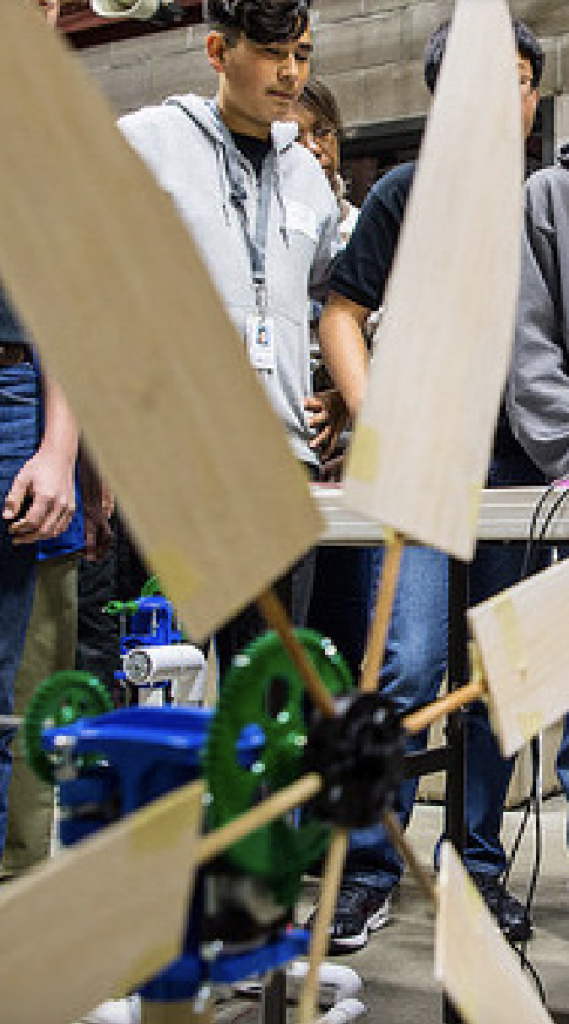

Towers
You can make a tower for your wind turbine out of practically anything. Check out these plans to make a simple PVC tower turbine or get a simple KidWind tower from Vernier.
Don’t limit yourself to just these towers! In fact, if you want to win you will need to adapt! We have seen some great towers made from wood, cardboard tubes, Tinker-Toys, plastic, etc.
Try experimenting with different designs! Which type of tower seems strongest? Why do you think certain wind turbines use the type of towers they use?
The only rule for making your tower is that it must have a firm base to sit securely on the ground, and it must be tall enough so that your blades will not hit the ground. If your turbine has a gear or pulley system, you will need to have some kind of platform or housing on top of your tower to hold the gear/pulley box.

Fans or Wind Tunnels
You can use any fan to test your turbine. At our workshops and while we are preparing and tinkering, we like to use simple box fans. At KidWind Challenge events, we will have a KidWind Competition Wind Tunnel (KW-TUN) or something very similar to test your turbine. The KidWind Competition Wind Tunnel is easily constructed and can be purchased from our partners at Vernier.
If you are handy, you can try to construct your own – many teachers have done this! Unlike a box fan, our tunnels suck the air through the shroud which leads to cleaner, less turbulent winds.

Power Measurement
You will need to learn how to measure power output from your turbine. You can use a simple multimeter or data logging equipment. The key is to make sure that your turbine is attached to a load whenever you are collecting data. What’s a load? Time to do some homework.
Through our partners at Vernier, you can get more sophisticated data collection equipment. We really love their Go Direct energy Sensor (GDX-NRG). It connects to all devices and is an easy way to collect detailed turbine data and even has a built in load.
Power Conditioning
We will allow devices (buck boost or other electronics) that reduce the output voltage and current from competing turbines to meet our 30V and 1A data collection limitations. We will not allow devices that increase the voltage or current from your turbine.

Turbine Design Rules
As you construct your turbine, please keep the following rules in mind:
- Each team that registers must have its own turbine. You will not be allowed to modify another team’s turbine and use it for testing. Teams cannot share one turbine and simply change blades or other parts for each team.
- The turbine must fit inside the wind tunnel and operate within its 48” x 48” internal dimensions. It is HIGHLY recommended that you design your turbine to fit within these dimensions with plenty of room. Sand bags or other weights will be available to hold the turbine in place, but we have found that almost all turbines shake and move a little in the tunnel, so it is a good idea to have extra space!
- There are no budgetary restrictions for your turbine design, but it is important to keep in mind that part of the judging process is the economical use of resources. Please use materials responsibly.
- You may only use 1 generator per turbine.
- Power must be generated solely by wind, using the wind tunnel.
- Your turbine can be built on either a vertical or horizontal axis.
- Your turbine may use a gearbox, pulley system, or similar mechanism to increase power output. You may use pre-manufactured gearboxes and other parts, but keep in mind that innovation is a critical judging criteria, and parts that you make on your own will earn you more points.
- You cannot use pre-manufactured wind turbine blades or airfoils/sheets.
- Your wind turbine must be free-standing. A tower/stand will not be provided.
- Metal, plexiglass, and similar blade materials are highly discouraged because they are potentially dangerous. On occasion, we have allowed these types of blades to be used, but only after local judges determined that there was an extremely low risk of failure due to assembly. Send us photos if you are unsure at info@kidwind.org. Please be aware that turbines will be disqualified if they are deemed unsafe by the local judges.
- The use of 3D printed parts and components is allowed. While you do not have to use files you created yourself, you should bring documentation about the CAD files to the Challenge and be prepared to discuss the design and the 3D printing process. Judges will want to make sure you understand this technology if you decide to use it.
- Students have used wheels from bicycles as part of their turbines. These are allowed since bike wheels are designed to spin at high RPM. Please be aware that if the wheel assemblies appear unsafe, local judges will disqualify these turbines.
- Shrouds are no longer allowed.
Connection and Loads
- You must have two wires at the base of your turbine. You must label which wire is positive and negative. Your turbine must produce DC power for our data logging system. If you make your own generator and it is generating AC power, you must rectify it to DC power.
- Teams that use KidWind Generators will be testing using a 30 ohm load.
- Teams in the OPEN DIVISION who construct their own generator or use an advanced generator are allowed to provide their own load during testing. They must provide the load and have it inspected by local judges. Teams may not use Maximum Power Point Tracking (MPPT) devices or variable resistors. Only static loads are allowed as the wind speed of the tunnel is not variable. You will be allowed to change your load between each test. You cannot change the load during a test. If you do not provide a load, your turbine will be tested at 30 ohms.

Local judges have the final call for safety. If you’re not sure about something, send a photo to info@kidwind.org.
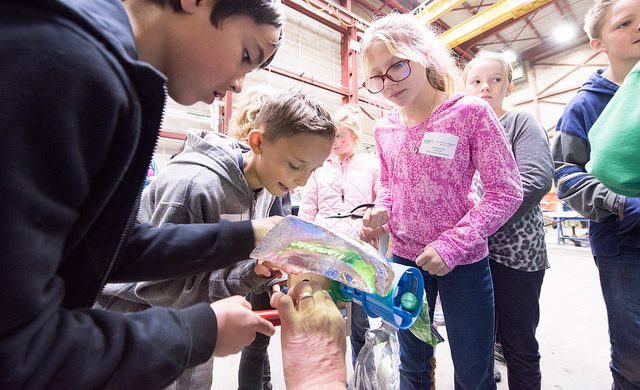
Power Output
- Our data-logging software and hardware can measure Direct Current at 30V/1A. Teams in all divisions must make sure to regulate their power output below these specifications. If your turbine exceeds this output, even for a millisecond, it will be disqualified as the equipment will not be able to properly record its power and energy output. This is very important!
- If your turbine produces so much power that it damages the generator before testing is complete, you will be able to retest your turbine as long as you can repair or replace your generator.
- If your turbine produces so much power that it damages the generator before testing is complete, you will be able to retest your turbine as long as you can repair or replace your generator.
Turbine Design Rules

Wind Tunnel
- Wind turbines will be tested in a 48” x 48” wind tunnel at a wind speed of approximately 3.5 to 5 m/s. Wind moving at 3.5 m/s within a space this large is much more powerful than a single box fan. Test your device for high winds! Watch for blade deformation or deflection and excessive torque on your gearboxes.
- All teams will be given time to tweak their turbine in the tunnel before actual testing begins. How much time will be determined by the type of event, number of entries, and free time available.
- Unlike a typical box fan, our wind tunnel sucks wind through it instead of pushing it. This creates a more powerful and consistent airflow to streamline testing. This should not affect the design requirements for your turbine.

Turbine Testing
- Once the testing session begins, you will be given two minutes to set up your wind turbine inside the tunnel.
- If you are using a KidWind Generator, the wires at the base of your turbine will be attached to a circuit with a 30 ohm resistor in series and will simultaneously measure voltage and amperage.
- If you are using a homebuilt or advanced generator, you will attach your desired load to the turbine or our measurement tools and then attach the wires at the base of your turbine to the circuit that will simultaneously measure voltage and amperage.
- In order to receive full marks for functionality, your wind turbine must be able to start producing power without external assistance once the wind tunnel is activated.
- Once your turbine is in the tunnel and connected to the data collection system, the judge will turn on the fans and ask your team if you want this test to count. If your team says yes, the judges will collect data on your turbine. If your team says no, you may remove your turbine, make a small tweak and try again. If there is a line of students waiting, you will probably need to head to the back of the line. This process will vary depending on the event.
- During testing, the wind tunnel will be running constantly. We will collect power and energy output data between 30-60 seconds. Your energy output source will be calculated using a Vernier data logging system that collects voltage and amperage readings simultaneously .
- If your turbine produces so much power that it damages the generator before testing is complete, you will be able to retest your turbine as long as you can repair your generator. If you are unable to record power and energy data with our equipment due to generators overheating, your turbine may not receive a power and energy score.
- Depending on your local Challenge rules, size, and time frame, you may have between 1 and 5 trials for testing, and only your best trial will contribute to your final score.
- Local judges have final say on rulings and disputes.
Defining Catastrophic Failure
An event that causes a turbine in the wind tunnel to produce zero power while collecting test data is defined as a Catastrophic Failure Event. This could be due to either a mechanical or electrical failure. If this happens you will be offered the following options. You will either be given two minutes to set up your wind turbine again, or you will be allowed to remove the turbine to make repairs. In the latter case, you will be moved to the back of the line for retesting.
Failures that lead to REDUCED performance are NOT considered catastrophic and a retest would not be allowed under these circumstances.
How Will Your Turbine and Team Be Evaluated?
At every KidWind Challenge, teams can expect to be evaluated on energy produced. Depending on the local event and the number of teams present, there may be turbine judging and instant challenges that are also part of your overall score.

Please keep in mind that Judging Rubrics and categories may be different at your local event. Your local organizer will share details of how your turbine will be evaluated prior to your event.
Energy Produced (35%)
The total energy output of your turbine over the 30-50 second trial period will be collected using data-logging software. Each team’s energy output will be ranked relative to that of other competitors. Each team will receive points corresponding to its rank.
Energy scores will be ranked on a comparative basis using one of two methods:
Rank Method
Turbines will be ranked by energy output. The highest producing turbine will receive the full number of available energy points, the following turbines will receive points based on rank with a 2-5 points deduction for each position they are from the top turbine.
Example: The top turbine produces a total of 100J and receives 35 points. Your turbine is ranked 6th at 80J and each rank down receives 2 less points. You get 25 points.
Ratio Method
Turbines will all be ranked by energy output. The highest producing turbine will receive the full number of available energy points. All other scores are calculated based on the percentage of the top score.
Example: The top turbine produces a total of 100J and receives 35 points. Your turbine produces a total of 80J, so your team would receive 80% or 28 points.
In all cases, you want to generate as much energy as possible to get a high score.
Turbine Design (30%)
A panel of judges will examine your wind turbine design at a KidWind Challenge. This 15-20 minute interview is to get a better understanding of the process you went through as you designed and tested your turbine. You should be prepared to discuss/defend the choices you incorporated into the design.
Questions judges may ask about your turbine design.
- Does your turbine have a gearbox, a pulley system, or is it direct drive?
- Did you have any issues with friction? How did you reduce friction in your drive train?
- When building your turbine, what kinds of obstacles or challenges did you face?
- How did you balance your blades? Do you notice any vibration when your turbine spins up to speed?
- Why are modern wind turbine blades shaped like airfoils? Are your blades shaped like airfoils? Did you try to make any airfoils?
- How did you determine the number of blades you would use? Did you perform any experiments?
- How did you determine the pitch (angle) of the blades?
- Why are your blades as long as they are?
- What materials did you use to make your blades? Why? What was imporant as you were building your blades?
- What techniques did you use to increase the power output of your wind turbine?
- What materials did you use to make your tower? What were some of the challenges you faced making a tower?
- What changes did you make to your turbine that led to the most performance gains?
- Discuss the craftsmanship of your design, including creativity, economic, and environmental decisions.
- Did you use recyclable materials?
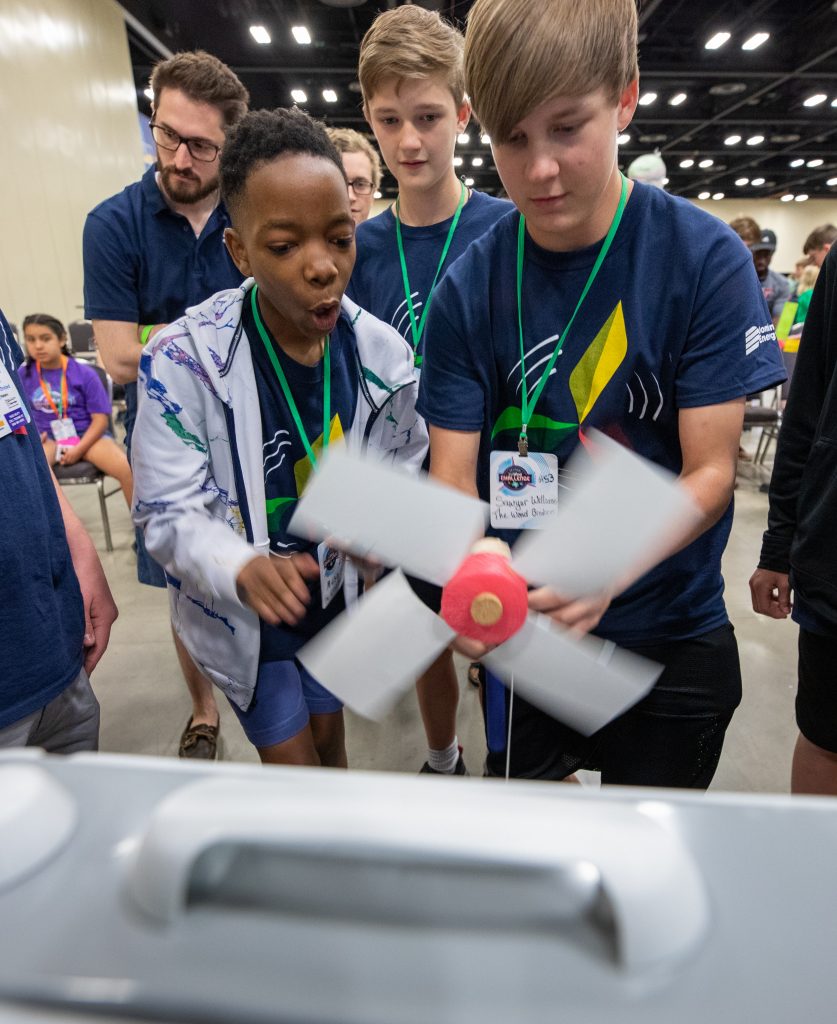
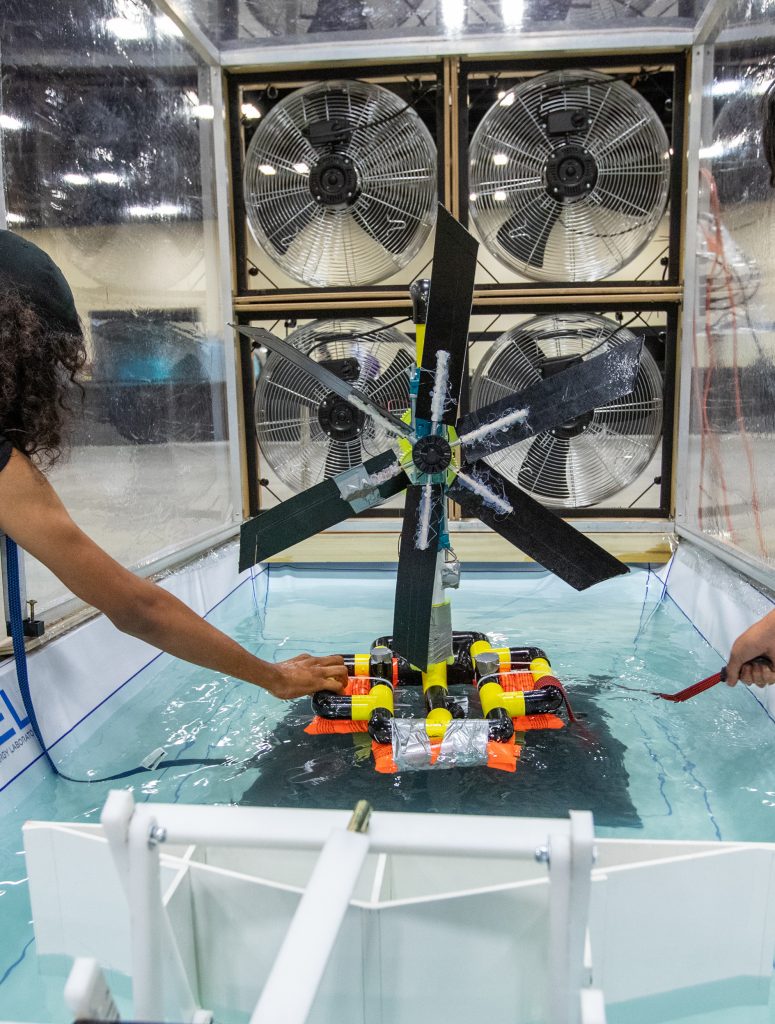
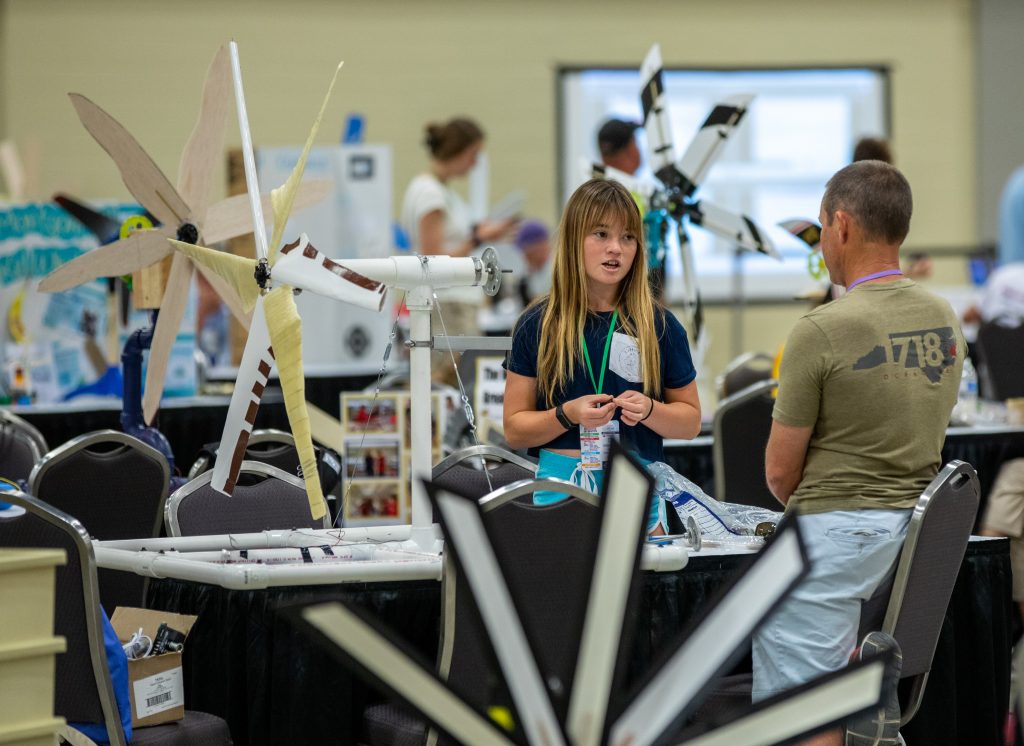
Written Documentation of Design (20%)
All students must complete a Project Profile Form (see Appendix). This sheet should be presented to your judges when you enter the judging room.
In addition to this sheet, teams may also share additional documentation with the judges that showcases, with more detail, their design process and knowledge of wind energy science. It is up to each team to determine how they want to document this part of their project. In the past we have seen:
- Short reports
- Engineer’s notebooks
- Videos (maximum of 4 minutes)
- PowerPoints
- Science fair poster boards
Instant Wind Challenges (15%)
At some KidWind Challenges, students may be asked to put their knowledge of wind energy to work at an Instant Challenge. Instant Challenges don’t require any preparation or planning before the Challenge, just a solid knowledge base to refer to for on-the-spot engineering.
These challenges may include building a windmill to lift weights using common household materials, or designing sails to most efficiently catch the wind.
The number of points that these Instant Challenges are worth will vary among Challenges.
During past Challenges, Instant Challenges have added 10-20 points to the final score. At some locations, we may be piloting bonus Instant Challenges and other categories for testing. Please check the KidWind Challenge website and your local Challenge registration page for more details.
